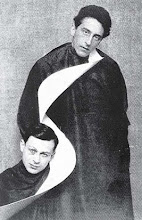Portland post-storm double rainbow from DiMillo’s upper deck.
For the last several years I’ve occasionally sojourned in Portland on Maine’s shoreline and
I’ve come to realize how much I love
it there.
Last
Monday morning, we made our Escape
From New York, which truly seemed like Hell the previous evening (more about that another time soon). Six hours later we stopped the car in Portland; the world turned about-face and seemed right again.
A plaque attached to a section of the Berlin Wall, DiMillo’s
wharf.
It’s not
the city's beauty so much because Portland
is not particularly beautiful. Unlike its neighbor Manchester, New Hampshire, Portland's brick-brick-brick
building style has no
powerful, distinctive, if slightly oppressive,
rhythm. Rather, Portland’s appeal lies in its broad, clear sky views, hills that afford pedestrians and drivers city
vistas and bring heaven closer, marine fragrances and friendly, courteous people. Unlike everywhere I’ve ever lived or visited, Portland drivers are uniformly polite and no one seems anxious to run
you over.
Painting on reverse of Berlin Wall section.
On our next-to-last day in town, we took a morning whale
watching trip out
Casco Bay and into the North Atlantic. We
saw minke
whales, which is always a thrill, many dolphins, harbor seals and pelagic birds. The trip's highlight, however, was our
encounter with four or five ocean
sunfish. Odyssey Voyage’s
resident naturalist announced the first sighting by saying that we had a real
treat in store for us – “one of
the weirdest animals we would ever see” – and he was right. I was completely unfamiliar with the species
Mola mola, but I have attached the Wikipedia article here (Link) if
you’re interested. (I think you should
be.) All I can say is that these enormous, unique creatures floated close to the sides of our vessel near
the ocean's surface, clearly
and curiously seeking social interaction. They
stretched themselves out in the oddest
conformations I had ever seen among fish and when we departed they waved at us with their fins extended
in the air. They reminded me of
cats.

Ocean Sunfish floating on its side with fin emerging from water,
Casco Bay.
Later that day, we visited
the Portland Museum of Art for
the first time and it was a revelation.
Housed in a handsome, non-officious,
non-clichéd (finally) I.M. Pei
structure which suits the city’s reserved,
proper, but informal style, the Portland collection is generally superb in
quality. It possesses and amplifies local integrity and
accurately reflects the city of Portland and state of Maine without taking on the character of a local historical society.
Also, because it is a fairly small museum (only about 17,000 objects all
told), it tells its story
succinctly, but in a way that makes you want to “read” it again.
The exhibitions currently on view are The Draw Of The Normandy
Coast 1860-1960 and Maine
Sublime: Frederic Edwin Church’s Landscapes of Mount Desert and Mount Katahdin. The shows are both excellent and are complementary in the way they each draw on coastal representations, albeit views from different continents.
They are complementary also in the way they both project – more distinctively than I’ve ever
seen at any museum exhibition – the joyous feelings that invariably accompany
seaside excursions, loci where water’s visual, tactile, sonic and olfactory effects are enhanced by stony formations on land and in the
surf.
Félix Vallotton, Edouard Vuillard Drawing At Honfleur, 1902, Oil
on cardboard.
The Normandy Coast exhibition, with
paintings, watercolors and drawings from Trouville, Deauville, Honfleur,
Étretat and Le Havre includes great works by the French artists Claude
Monet, Edgar Degas, Gustave Courbet, Félix Vallotton (his wonderful portrait of his friend Edouard
Vuillard sketching is shown above), Maurice Vlaminck, Henri Matisse and two surprising
contributions by Yves Tanguy and Marcel Duchamp (a really nice early painting of the Normandy
surf and cliffs, showing Monet’s influence.)
The show also includes work by American painters resident in France including Samuel Coleman,
George Inness and James A.M. Whistler and by the Dutch painter Johan Barthold Jongkind.
The nineteenth and early twentieth century pictures are really the heart of
the show and the exhibition catalogue’s descriptions of Normandy’s social
history, its relation to the arts and the interactions among the painters who worked so productively there, are
fascinating and actually uplifting.
Whatever these artists’ individual points of view, you have a feeling
that they all found that things
seemed better at the beach.
The morning we checked out of our hotel, during a trip to the
lobby to get coffee to aid with our suitcase packing, I realized that I wanted to have a job that would allow me to
return to Portland regularly so that
I could regularly revisit many eye-opening items in the museum’s permanent
collection (which includes some really superb
Marsden Hartleys, Winslow
Homers, as well as the best examples I have ever seen of N.C. Wyeth’s work) and continue
to research and enjoy Portland’s fine restaurants. (We found several that the guide books don’t
tell you about and one or two they do mention, which you should avoid unless Pan-Fried Maine Farm Rabbit Livers or Wood-Roasted Lamb Hearts are the reason for your visit to the north country.)
The
occasion for our trip – the Maine Event, as it were -- was visiting Jane at camp. She had grown noticeably taller and was
cheerful, charming, witty and sensible. That was spectacular.
_Frederic_Edwin_Church.jpg)
+1988+art+institute+of+chicago.jpg)









